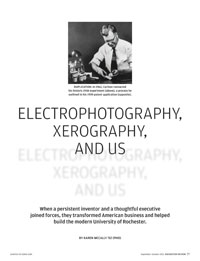Features
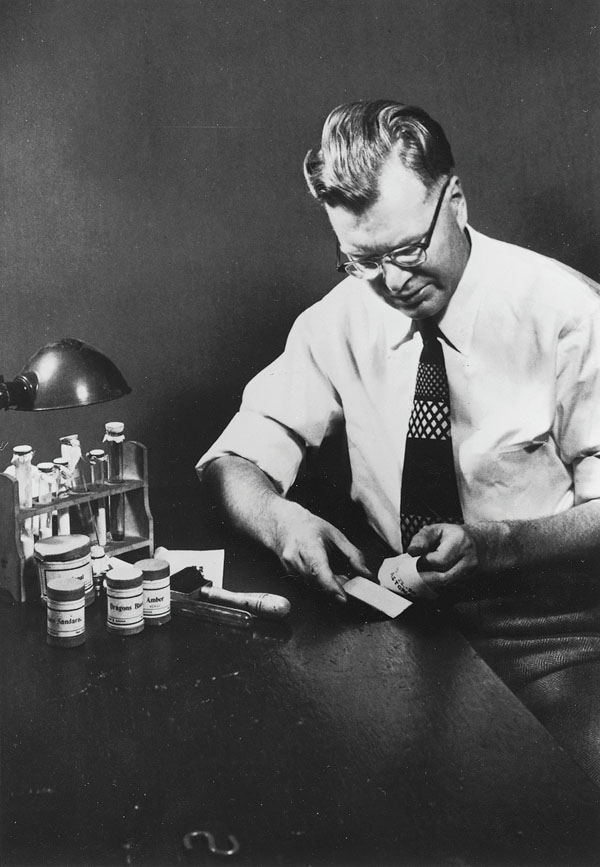 DUPLICATION: In 1962, Carlson reenacted his historic 1938 experiment (above), a process he outlined in his 1939 patent application. (Photo: Courtesy of Xerox Corp.)
DUPLICATION: In 1962, Carlson reenacted his historic 1938 experiment (above), a process he outlined in his 1939 patent application. (Photo: Courtesy of Xerox Corp.)It was a cramped, second-story room at 32–05 37th Street in Astoria, Queens, in which Chester Carlson set his sights on testing the process he called electrophotography. A converted kitchen, it contained a sink with running water, a gas connection, and enough space for the tinkerer and his hired assistant to maneuver amidst their setup of jars, plates, and a small flood lamp.
Carlson was a serial inventor. He was a trained physicist about to earn a second degree, in the law. He’d kept notebooks since high school, chock full of drawings and notations recording his ideas for an array of devices. A rotating billboard. A machine to clean shoes. A raincoat with gutters.
Otto Kornei was an unemployed physicist who found a part-time job assisting Carlson his lone prospect in Depression-era New York.
What they accomplished on the morning of Oct. 22, 1938, would prove historic.
Carlson was ingenious conceptually, but Kornei was the first of many scientists who would play an important role in executing Carlson’s ideas through careful fine-tuning of materials and methods. Kornei pulled the shades closed, and in the darkened room, coated a zinc plate with sulfur. He rubbed the plate with a cotton handkerchief, giving the plate an electric charge. He took a glass slide on which he’d written “10–22–38 ASTORIA” in India ink, pressed it against the charged plate, and placed both the slide and plate under a lamp. After 10 seconds, he removed the plate and dusted it with a fine powder. When he blew on the powder, the image 10–22–38 ASTORIA shone on the plate.
It was the first known electrostatic image, a major technological milestone. It now sits in the Smithsonian, but might well have been discarded unceremoniously had it not been for Carlson’s persistence and the prescience of Joseph Wilson ’31, a young executive of a struggling business who saw the potential of electrophotography that so many others missed.
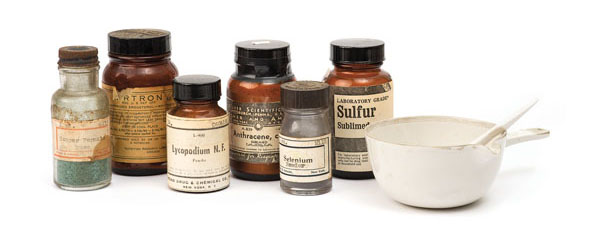 ORIGINALS: Jars of substances that Carlson used to produce the first electrostatic image (below), are showcased in the University’s Carlson Library. (Photo: Adam Fenster)
ORIGINALS: Jars of substances that Carlson used to produce the first electrostatic image (below), are showcased in the University’s Carlson Library. (Photo: Adam Fenster)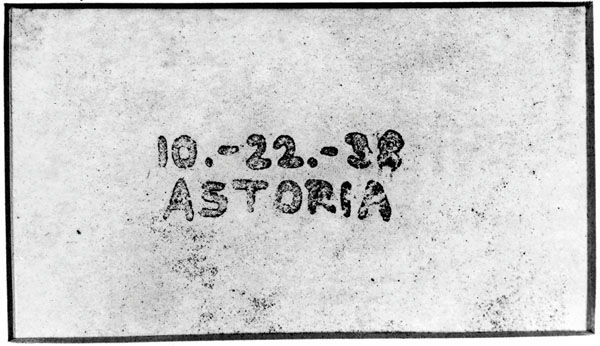 (Photo: Courtesy of Xerox Corp.)
(Photo: Courtesy of Xerox Corp.)This October marks the 75th anniversary of Carlson’s Astoria experiment. On the River Campus, students and staff in the Chester F. Carlson Library of Science and Engineering have long observed the October anniversary, but this year’s celebration will feature a new exhibit that Melissa Mead, the John M. and Barbara Keil University Archivist and Rochester Collections Librarian, has titled “True Original: Chester Carlson’s Xerography at 75.”
The exhibit will place Carlson’s invention in historical context and showcase the complementary relationship between Carlson and Wilson in exploiting its possibilities.
“I hope that exhibit viewers will have a better understanding of the duplication processes available prior to the 914, and the transformative vision of both Carlson and Wilson that led to xerography as a process and as a business,” says Mead, alluding to the Xerox 914 photocopier that transformed the American office when it was introduced in 1959.
The University is a fitting place for such a display, and not merely because it will grace the library dedicated to Carlson in 1972 by then President W. Allen Wallis. It will draw from the University’s substantial collections of artifacts, papers, and photographs of both Carlson and Wilson. And it will suggest the interdependence of research universities and the communities in which they operate.
Both Carlson and Wilson established charitable foundations that continue to contribute handsomely to the Rochester regional economy. Wilson in particular grasped the importance to business of having access to a first-tier research university, and in his roles as benefactor and as chairman of the board of trustees, presided over a transformation of the University in the 1960s from a respected regional institution to a top research university with a national reputation. Wilson, it’s fair to say, left as indelible a mark on the University as George Eastman.
The fortuitous encounter between Carlson and Wilson has made for a classic story in the annals of American business history. Carlson grew up in poverty, worked his way through Caltech, toiled for years on his ideas, only to have his breakthrough invention dismissed by virtually every company he approached.
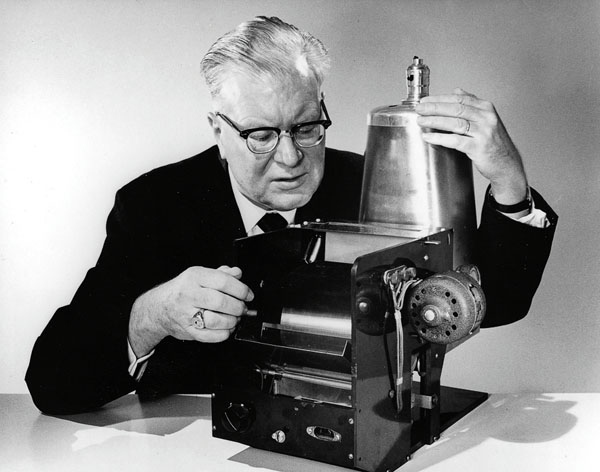 REPLICATION: Carlson (above) demonstrates the first xerographic machine. A replica of the 1944 machine is on display in the
Carlson Library. (Photo: Courtesy of Xerox Corp.)
REPLICATION: Carlson (above) demonstrates the first xerographic machine. A replica of the 1944 machine is on display in the
Carlson Library. (Photo: Courtesy of Xerox Corp.)Wilson was the one businessman who was intrigued—so intrigued that he staked the future of his small photographic paper manufacturer, Haloid, on Carlson’s invention. The investment created a corporation that revolutionized the white collar workplace, and whose new name, Xerox, became synonymous with photocopying itself.
When Wilson met Carlson in October 1946, “their meeting would mark the turning point for both,” wrote Wilson biographer Charles Ellis, a prolific author and businessman. In some respects, they could not have been more different. Carlson had moved three times by the time he was six, lost his mother when he was an adolescent, and worked to support himself and his father, who suffered from debilitating spinal arthritis. Having finished his schooling during the Great Depression, he hopped from job to job to piece together satisfactory and remunerative work.
Wilson was born in Rochester to a family whose roots extended to the city’s earliest settlements. His father, Joseph R. Wilson, Class of 1903, was an accomplished small businessman and civic leader, and when Wilson graduated from Rochester in the midst of the Depression, there was a job waiting for him at Haloid, the company cofounded by his grandfather.
But Carlson and Wilson shared a couple of key tendencies. They were, by many accounts, deep and thorough readers, and persistent and creative thinkers. In their respective fields of science and business, both Carlson and Wilson were keenly aware of the paths that were well tread, and the importance of avoiding them in favor of new ones.
Carlson, who would eventually have numerous patents to his name, took an early interest in patents, finding employment in the patent office of the electrical components manufacturer P. R. Mallory. Patents required many copies to be made, but making carbon copies proved difficult, as did another available method, using a photostat machine. Carlson envisioned an “office copier,” yet he knew not to go down the obvious route, which was conventional photography.
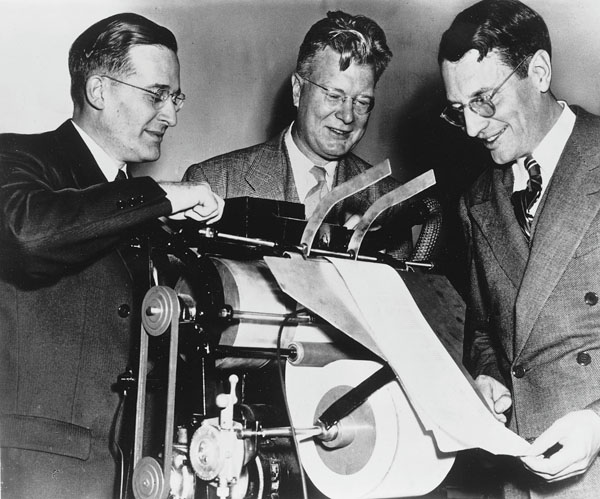 ROLLOUT: Haloid’s John Dessauer, Carlson, and Wilson test an experimental xerography machine at the Battelle Institute in 1948. (Photo: Courtesy of Xerox Corp.)
ROLLOUT: Haloid’s John Dessauer, Carlson, and Wilson test an experimental xerography machine at the Battelle Institute in 1948. (Photo: Courtesy of Xerox Corp.)“I recognized quite early that if conventional photography would have worked for an office copier that it would have been done before by the big companies in the photographic field who certainly would have explored that possibility pretty thoroughly,” Carlson said in a 1965 interview. “So I deliberately turned away from the conventional photographic processes and started searching in the library for information about all the different ways in which light will affect matter.”
The principle Carlson would explore was photoconductivity, and it was well understood by the time he set out to explain in his 1939 patent application how it might be brought to bear upon electrophotography.
Photoconductive materials become better conductors of electricity when exposed to light. Carlson explained that if a thin layer of photoconductive material were to be applied to certain types of metal surfaces—zinc or aluminum, for example—the surface could be exposed to light to create an electrostatic image.
In the case of the Astoria experiment, sulfur was the photoconductive surface. Rubbed with a handkerchief in the dark, it obtained an electric charge. When Kornei pressed the glass slide against the charged surface, he ensured that whatever effect exposure to light would have on the charged surface would be transferred to the slide.
The Road to the 914
It took more than a decade for Haloid, renamed Xerox in 1961, to harness Carlson’s electrophotography to create the first successful photocopying machine, the Xerox 914.
- 1949 The XeroX Model A marked Haloid’s first attempt to produce a xerographic photo-copying machine. Requiring more than a dozen manual steps to operate, it was poorly received.
- 1956 The Copyflo, which was fully automated, was a major improvement over the Model A. However, at the size of a small truck, it was also prohibitively expensive for the mass business market.
- 1959 The Xerox 914, named for its ability to photocopy on 9” x 14” paper, was not without flaws. But a relatively small size, reasonable cost, and skillful marketing made it a hit. It graced the cover of Time magazine in September 1959.
But the India ink he’d applied to the slide created a region that would literally be blacked out from the effect of the light. When the slide and the charged plate were illuminated, the sulfur surface retained its electric charge in areas blocked out by the ink. The rest of the plate constituted, Carlson explained, the “white part,” in which the electrical charge would essentially “drain off.” When Kornei applied a fine black powder to the plate, static electricity ensured that the powder would remain affixed in a layout identical to his original ink scrawl.
Carlson allowed great flexibility in materials and even in the process itself. He outlined procedures for copying from three distinct types of surfaces—glass, paper, and film. “While a preferred embodiment of the invention is described herein, it is contemplated that considerable variation may be made in the method of procedure and the construction of parts without departing from the spirit of the invention,” Carlson wrote.
As it turned out, that flexibility—which could too easily be interpreted as the lack of a fully fleshed-out idea—may have been the seed of his problems. He began writing to companies in the office equipment industry seeking their interest in developing the patent. He wrote to more than 20—IBM, RCA, General Electric, Remington Rand—all major players in the industry. He received, at best, perfunctory interest, with minimal follow up, and no firm commitments.
Carlson had found himself in a Catch-22. Prospective investors wanted to see more than the crude demonstration he’d performed with Kornei’s help. They needed to see a machine. But without investors, Carlson couldn’t easily produce a machine. He tried hiring small manufacturers to produce a machine cheaply, but those earliest manifestations were marred by mechanical and design problems—evidence, it seemed, that electrophotography wasn’t as promising as the persistent inventor insisted.
Timing also played a critical role in Carlson’s fortunes. It was World War II. Large companies were focused on war-related production and were confident that they’d continue to prosper after postwar reconversion to civilian industry.
Wilson, however, was just as confident that without a new business model, his small company would fail.
Carlson would later recall that Wilson was “a very brilliant young man,” who had struck him immediately as “an aggressive, young, imaginative person.” Wilson, then 36, had recently succeeded his father, Joseph R. Wilson, as president of Haloid, a company that had started in 1906 as a maker of photographic paper.
Wilson saw that the postwar period looked ominous. His hometown competitor, Eastman Kodak, was supplying its own paper, squeezing Haloid into a niche market of specialized paper for portrait photographers. To make matters worse, Haloid was purchasing raw materials for its paper from Kodak.
Haloid had been dogged by Kodak’s success even before the war. In 1935, it had purchased the Rectigraph Company, for whom it had been a key supplier. Rectigraph was the maker of the eponymous machine that’s considered among the first photocopying machines. But it was not an office copier in any real sense. It was a photostat machine, copying documents through a photographic process that relied on a camera and a chemically based development process. It was large, slow, messy, and expensive. Moreover, it was too large and expensive for most businesses to own themselves, limiting its market to shops that would offer the machine’s services as a primary line of business. While the purchase kept Haloid afloat through the Depression, Wilson knew that Kodak would quickly surpass any advantage of Haloid’s in photographic copying.
“There are those in financial circles who say that chance and luck brought the Xerox Corporation into existence,” the chemical engineer and Xerox executive John Dessauer wrote in his 1971 memoir, My Years with Xerox. “I prefer to think that it was a matter of diligence.”
Dessauer was among the scientists at Haloid who scoured technical journals in search of ideas for new applications that could lead to new products that could save the company. The first turning point for both Wilson and Carlson came in 1944. The nonprofit Battelle Memorial Institute committed to investing $10,000 in Carlson’s patent, with an entitlement to 60 percent of any future royalties. Scientists at Haloid tipped Wilson off to the technology and to Battelle’s interest.
Wilson was captivated. After some further research, he traveled to Battelle’s Columbus, Ohio, laboratory to see a demonstration of electrophotography for himself.
Committing Haloid to invest in the technology would be a huge risk. Nevertheless, at Wilson’s urging, Haloid, renamed Haloid-Xerox in 1958, and Xerox in 1961, would invest virtually all of its resources in the development of the technology it later coined “xerography.”
In hindsight, Wilson’s dogged pursuit of xerography seems easy to explain. The purchase of Rectigraph had signaled Haloid’s commitment to the nascent document copying business. Electrophotography was a potential means for document copying that wasn’t based on chemistry, which was Kodak’s strength. It was based instead on physics. For Wilson, electrophotography offered the promise that Haloid could compete in the copy business without competing directly with Kodak.
What’s more remarkable is that Wilson was able to carry this commitment through more than a decade of failed attempts and modest progress before the release of the blockbuster Xerox 914 photocopier in 1959.
Taking that risk made Wilson a modern business hero. “Wilson was, in retrospect, astonishingly able to develop and hold steadfastly onto an inspiring yet abstract vision and to advance repetitively toward fulfilling and realizing that vision in specific, pragmatic ways,” Ellis wrote.
Carlson, whom Wilson retained as a consultant in the development of xerography, summed up his legacy succinctly. Modest by all accounts, he insisted he didn’t invent anything truly new. “I certainly added no new scientific knowledge as did the transistor inventors, for example,” he said. But what he did acknowledge doing, is at the heart of much innovation: “I merely combined a set of facts in a new way.”
